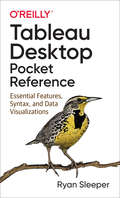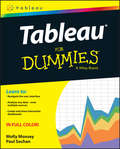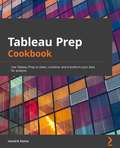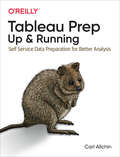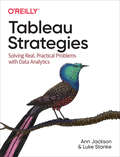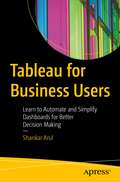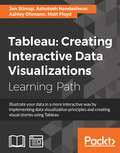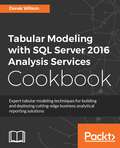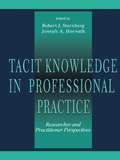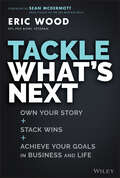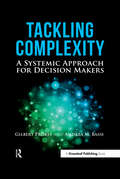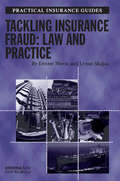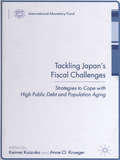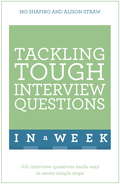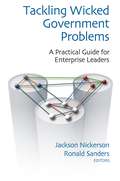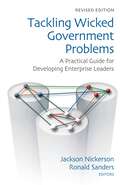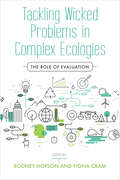- Table View
- List View
Tableau Desktop Pocket Reference: Essential Features, Syntax, and Data Visualizations
by Ryan SleeperIn a crowded field of data visualization and analytics tools, Tableau Desktop has emerged as the clear leader. This is partly due to its ease of use, but once you dive into Tableau's extensive feature set, you'll understand just how powerful and flexible this software can be for your business or organization.With this handy pocket reference, author Ryan Sleeper (Innovative Tableau) shows you how to translate the vast amounts of data into useful information. Tableau has done an amazing job of making valuable insights accessible to analysts and executives who would otherwise need to rely on IT. This book quickly guides you through Tableau Desktop's learning curve.You'll learn:How to shape data for use with Tableau DesktopHow to create the most effective chart typesCore concepts including discrete versus continuousMust-know technical features including filters, parameters, and setsKey syntax for creating the most useful analysesHow to bring it all together with dashboardsAnd more!
Tableau For Dummies
by Molly Monsey Paul SochanMake your data work for you! Tableau For Dummies brings order to the chaotic world of data. Understanding your data and organizing it into formats and visualizations that make sense to you are crucial to making a real impact on your business with the information that's already at your fingertips. This easy-to-use reference explores the user interface, and guides you through the process of connecting your data sources to the software. Additionally, this approachable, yet comprehensive text shows you how to use graphs, charts, and other images to bring visual interest to your data, how to create dashboards from multiple data sources, and how to export the visualizations that you have developed into multiple formats that translate into positive change for your business. The mission of Tableau Software is to grant you access to data that, when put into action, will help you build your company. Learning to use the data available to you helps you make informed, grounded business decisions that can spell success for your company. Navigate the user interface to efficiently access the features you need Connect to various spreadsheets, databases, and other data sources to create a multi-dimensional snapshot of your business Develop visualizations with easy to use drag and drop features Start building your data with templates and sample workbooks to spark your creativity and help you organize your information Tableau For Dummies is a step-by-step resource that helps you make sense of the data landscape--and put your data to work in support of your business.
Tableau Prep Cookbook: Use Tableau Prep to clean, combine, and transform your data for analysis
by Hendrik KleineExplore common and not-so-common data transformation scenarios and solutions to become well-versed with Tableau Prep and create efficient and powerful data pipelinesKey FeaturesCombine, clean, and shape data for analysis using self-service data preparation techniquesBecome proficient with Tableau Prep for building and managing data flows across your organizationLearn how to combine multiple data transformations in order to build a robust datasetBook DescriptionTableau Prep is a tool in the Tableau software suite, created specifically to develop data pipelines. This book will describe, in detail, a variety of scenarios that you can apply in your environment for developing, publishing, and maintaining complex Extract, Transform and Load (ETL) data pipelines. The book starts by showing you how to set up Tableau Prep Builder. You'll learn how to obtain data from various data sources, including files, databases, and Tableau Extracts. Next, the book demonstrates how to perform data cleaning and data aggregation in Tableau Prep Builder. You'll also gain an understanding of Tableau Prep Builder and how you can leverage it to create data pipelines that prepare your data for downstream analytics processes, including reporting and dashboard creation in Tableau. As part of a Tableau Prep flow, you'll also explore how to use R and Python to implement data science components inside a data pipeline. In the final chapter, you'll apply the knowledge you've gained to build two use cases from scratch, including a data flow for a retail store to prepare a robust dataset using multiple disparate sources and a data flow for a call center to perform ad hoc data analysis. By the end of this book, you'll be able to create, run, and publish Tableau Prep flows and implement solutions to common problems in data pipelines.What you will learnPerform data cleaning and preparation techniques for advanced data analysisUnderstand how to combine multiple disparate datasetsPrepare data for different Business Intelligence (BI) toolsApply Tableau Prep's calculation language to create powerful calculationsUse Tableau Prep for ad hoc data analysis and data science flowsDeploy Tableau Prep flows to Tableau Server and Tableau OnlineWho this book is forThis book is for business intelligence professionals, data analysts, and Tableau users looking to learn Tableau Prep essentials and create data pipelines or ETL processes using it. Beginner-level knowledge of data management will be beneficial to understand the concepts covered in this Tableau cookbook more effectively.
Tableau Prep: Self-service Data Preparation For Better Analysis
by Carl AllchinFor self-service data preparation, Tableau Prep is relatively easy to use—as long as you know how to clean and organize your datasets. Carl Allchin, from The Information Lab in London, gets you up to speed on Tableau Prep through a series of practical lessons that include methods for preparing, cleaning, automating, organizing, and outputting your datasets.Based on Allchin’s popular blog, Preppin’ Data, this practical guide takes you step-by-step through Tableau Prep’s fundamentals. Self-service data preparation reduces the time it takes to complete data projects and improves the quality of your analyses. Discover how Tableau Prep helps you access your data and turn it into valuable information.Know what to look for when you prepare dataLearn which Tableau Prep functions to use when working with data fieldsAnalyze the shape and profile of your datasetOutput data for analysis and learn how Tableau Prep automates your workflowLearn how to clean your dataset using Tableau Prep functionsExplore ways to use Tableau Prep techniques in real-world scenariosMake your data available to others by managing and documenting the output
Tableau Strategies: Solving Real, Practical Problems with Data Analytics
by Ann Jackson Luke StankeIf you want to increase Tableau's value to your organization, this practical book has your back. Authors Ann Jackson and Luke Stanke guide data analysts through strategies for solving real-world analytics problems using Tableau. Starting with the basics and building toward advanced topics such as multidimensional analysis and user experience, you'll explore pragmatic and creative examples that you can apply to your own data.Staying competitive today requires the ability to quickly analyze and visualize data and make data-driven decisions. With this guide, data practitioners and leaders alike will learn strategies for building compelling and purposeful visualizations, dashboards, and data products. Every chapter contains the why behind the solution and the technical knowledge you need to make it work.Use this book as a high-value on-the-job reference guide to TableauVisualize different data types and tackle specific data challengesCreate compelling data visualizations, dashboards, and data productsLearn how to generate industry-specific analyticsExplore categorical and quantitative analysis and comparisonsUnderstand geospatial, dynamic, statistical, and multivariate analysisCommunicate the value of the Tableau platform to your team and to stakeholders
Tableau for Business Users: Learn to Automate and Simplify Dashboards for Better Decision Making
by Shankar ArulLearn Tableau by working through concrete examples and issues that you are likely to face in your day-to-day work. Author Shankar Arul starts by teaching you the fundamentals of data analytics before moving on to the core concepts of Tableau. You will learn how to create calculated fields, and about the currently available calculation functionalities in Tableau, including Basic Expressions, Level of Detail (LOD) Expressions, and Table Calculations. As the book progresses, you’ll be walked through comparisons and trend calculations using tables. A concluding chapter on dashboarding will show you how to build actionable dashboards to communicate analysis and visualizations. You’ll also see how Tableau can complement and communicate with Excel. After completing this book, you will be ready to tackle the challenges of data analytics using Tableau without getting bogged down by the technicalities of the tool. What Will You Learn Master the core concepts of Tableau Automate and simplify dashboards to help business users Understand the basics of data visualization techniques Leverage powerful features such as parameters, table calculations, level of detail expressions, and more Who is This book For Business analysts, data analysts, as well as financial analysts.
Tableau: Creating Interactive Data Visualizations
by Matt Floyd Ashutosh Nandeshwar Jen Stirrup Ashley OhmannIllustrate your data in a more interactive way by implementing data visualization principles and creating visual stories using Tableau About This Book * Use data visualization principles to help you to design dashboards that enlighten and support business decisions * Integrate your data to provide mashed-up dashboards * Connect to various data sources and understand what data is appropriate for Tableau Public * Understand chart types and when to use specific chart types with different types of data Who This Book Is For Data scientists who have just started using Tableau and want to build on the skills using practical examples. Familiarity with previous versions of Tableau will be helpful, but not necessary. What You Will Learn * Customize your designs to meet the needs of your business using Tableau * Use Tableau to prototype, develop, and deploy the final dashboard * Create filled maps and use any shape file * Discover features of Tableau Public, from basic to advanced * Build geographic maps to bring context to data * Create filters and actions to allow greater interactivity to Tableau Public visualizations and dashboards * Publish and embed Tableau visualizations and dashboards in articles In Detail With increasing interest for data visualization in the media, businesses are looking to create effective dashboards that engage as well as communicate the truth of data. Tableau makes data accessible to everyone, and is a great way of sharing enterprise dashboards across the business. Tableau is a revolutionary toolkit that lets you simply and effectively create high-quality data visualizations. This course starts with making you familiar with its features and enable you to develop and enhance your dashboard skills, starting with an overview of what dashboard is, followed by how you can collect data using various mathematical formulas. Next, you'll learn to filter and group data, as well as how to use various functions to present the data in an appealing and accurate way. In the first module, you will learn how to use the key advanced string functions to play with data and images. You will be walked through the various features of Tableau including dual axes, scatterplot matrices, heat maps, and sizing.In the second module, you'll start with getting your data into Tableau, move onto generating progressively complex graphics, and end with the finishing touches and packaging your work for distribution. This module is filled with practical examples to help you create filled maps, use custom markers, add slider selectors, and create dashboards. You will learn how to manipulate data in various ways by applying various filters, logic, and calculating various aggregate measures. Finally, in the third module, you learn about Tableau Public using which allows readers to explore data associations in multiple-sourced public data, and uses state-of-the-art dashboard and chart graphics to immerse the users in an interactive experience. In this module, the readers can quickly gain confidence in understanding and expanding their visualization, creation knowledge, and quickly create interesting, interactive data visualizations to bring a richness and vibrancy to complex articles. The course provides a great overview for beginner to intermediate Tableau users, and covers the creation of data visualizations of varying complexities. Style and approach The approach will be a combined perspective, wherein we start by performing some basic recipes and move on to some advanced ones. Finally, we perform some advanced analytics and create appealing and insightful data stories using Tableau Public in a step-by-step manner.
Tabular Modeling with SQL Server 2016 Analysis Services Cookbook
by Derek WilsonExpert tabular modeling techniques for building and deploying cutting-edge business analytical reporting solutions About This Book • Build and deploy Tabular Model projects from relational data sources • Leverage DAX and create high-performing calculated fields and measures • Create ad-hoc reports based on a Tabular Model solution • Useful tips to monitor and optimize your tabular solutions Who This Book Is For This book is for SQL BI professionals and Architects who want to exploit the full power of the new Tabular models in Analysis Services. Some knowledge of previous versions of Analysis services would be helpful but is not essential. What You Will Learn • Learn all about Tabular services mode and how it speeds up development • Build solutions using sample datasets • Explore built-in actions and transitions in SSAS 2016 • Implement row-column, and role-based security in a Tabular Data model • Realize the benefits of in-memory and DirectQuery deployment modes • Get up to date with the new features added to SQL Server 2016 Analysis Services • Optimize Data Models and Relationships Usage In Detail SQL Server Analysis Service (SSAS) has been widely used across multiple businesses to build smart online analytical reporting solutions. It includes two different types of modeling for analysis services: Tabular and Multi Dimensional. This book covers Tabular modeling, which uses tables and relationships with a fast in-memory engine to provide state of the art compression algorithms and query performance. The book begins by quickly taking you through the concepts required to model tabular data and set up the necessary tools and services. As you learn to create tabular models using tools such as Excel and Power View, you'll be shown various strategies to deploy your model on the server and choose a query mode (In-memory or DirectQuery) that best suits your reporting needs. You'll also learn how to implement key and newly introduced DAX functions to create calculated columns and measures for your model data. Last but not least, you'll be shown techniques that will help you administer and secure your BI implementation along with some widely used tips and tricks to optimize your reporting solution. By the end of this book, you'll have gained hands-on experience with the powerful new features that have been added to Tabular models in SSAS 2016 and you'll be able to improve user satisfaction with faster reports and analytical queries. Style and approach This book takes a practical, recipe-based approach where each recipe lists the steps to address or implement a solution. You will be provided with several approaches to creating a business intelligence semantic model using analysis services.
Tacit Knowledge in Professional Practice: Researcher and Practitioner Perspectives
by Robert J. Sternberg Joseph A. HorvathThose responsible for professional development in public and private-sector organizations have long had to deal with an uncomfortable reality. Billions of dollars are spent on formal education and training directed toward the development of job incumbents, yet the recipients of this training spend all but a fraction of their working life outside the training room--in meetings, on the shop floor, on the road, or in their offices. Faced with the need to promote "continuous learning" in a cost-effective manner, trainers, consultants, and educators have sought to develop ways to enrich the instructional and developmental potential of job assignments--to understand and facilitate the "lessons of experience." Not surprisingly, social and behavioral scientists have weighed in on the subject of on-the-job learning, and one message of their research is quite clear. This message is that much of the knowledge people use to succeed on the job is acquired implicitly--without intention to learn or awareness of having learned. The common language of the workplace reflects an awareness of this fact as people speak of learning "by doing" or "by osmosis" and of professional "instinct" or "intuition." Psychologists, more careful if not clearer in their choice of words, refer to learning without intention or awareness as "implicit learning" and refer to the knowledge that results from this learning as "tacit knowledge." Tacit Knowledge in Professional Practice explores implicit learning and tacit knowledge as they manifest themselves in the practice of six knowledge-intensive professions, and considers the implications of a tacit-knowledge approach for increasing the instructional and developmental impact of work experiences. This volume brings together distinguished practitioners and researchers in each of the six disciplines to discuss their own research and/or professional experience and to engage each other's views. It addresses professional practice in its totality -- from the technical to the interpersonal to the crassly commercial -- not simply a few aspects of practice that lend themselves to controlled study. Finally, this edited volume seeks to go beyond the enumeration of critical experiences to an understanding of the psychological mechanisms that underlie learning from experience in professional disciplines and, in so doing, to lay a foundation for innovations in professional education and training.
Tackle What's Next: Own Your Story, Stack Wins, and Achieve Your Goals in Business and Life
by Eric WoodTransform the next chapter of your life into the best one yet In Tackle What&’s Next: Own Your Story, Stack Wins, and Achieve Your Goals in Business and Life, NFL veteran and motivational speaker Eric Wood delivers an inspirational and insightful take on how you can prepare for the next big thing in your life. Whether you&’re riding high or feeling low, the author shows you how to make your &“What&’s next?&” into your best yet. In the book, Wood draws on his own experiences transitioning out of his NFL career and provides you with the tools you need to achieve success in your own circumstances. You&’ll explore: How to pivot between opportunities when life forces you to unexpectedly change direction Strategies for closely examining what you&’re good at, what you&’re great at, and what you can contribute to the world with your unique combination of gifts and talents Ways to adjust your perspective to maintain resilience and toughness in the face of adversityA can&’t-miss read for anyone looking for proven and straightforward ways to make the next chapter of their life even more exciting than what&’s come before, Tackle What&’s Next is your own personal handbook to achievement, resilience, and success.
Tackling Complexity: A Systemic Approach for Decision Makers
by Gilbert Probst Andrea BassiOur socio-economic systems continue to grow and evolve. We need to acknowledge that, consequently, our decisions often fail – they are ineffective and create unexpected side effects. The speed of execution is increasing constantly and markets and systems respond almost immediately, making decision-making challenging. There is little or no room for failure.This important new book analyses real world strategy and policy challenges, addressing the interconnectedness of the markets/systems we live in. It provides a step-by-step approach using systems thinking to solve complex problems in socio-political as well as business environment. It proposes a technique with which to better understand the problems and the context in which they arise, and tools to directly inform each step of the decision-making process. The book explores the main innovation that systemic thinking introduces – the emphasis on defining the problem creating system, which is made up of interacting parts, rather than prioritizing events that need immediate fixing.The case studies, examples and the approach proposed can be used to better understand reality and its complexity, and to integrate stakeholders for a better solution. Practically, it can be used to identify problems, analyse their boundaries, design interventions, forecast and measure their expected impacts, implement them and monitor and evaluate their success/failure. The book touches upon global issues related to policy making and strategic management, as well as issues related to sustainable development for both the public and private sector.
Tackling Difficulties in Tax Administration Reform: Reducing the Tax Burden of China
by Jia Kang Liang Ji Cheng YuThis book explores China's tax system- one of the largest in the world, it operates on a quite different logic in taxing income, property and capital gains compared with most other countries. In an effort to reduce income inequality and continue to drive robust growth, a lively debate about the reform of China's tax system is taking place. In this book, some of China's most prominent thinkers on the topic share their insights and proposals. This book will interest scholars of the Chinese economy, business analysts and scholars of taxation policy.
Tackling Environmental Health Inequalities in a South African City?: Rediscovering Regulation, Local Government and its Environmental Health Practitioners (Routledge Focus on Environmental Health)
by Rob CouchSouth Africa is widely recognised as a middle-income, industrialised nation, but it also ranks amongst the most unequal countries in the world in terms of its income distribution and human development. Environmental health remains a considerable public health challenge in the 21st century as Environmental Health Practitioners (EHPs) try to tackle local environmental health inequalities in the face of historically disadvantaged populations suspicious of their motives and demands that far exceed any resources available. Based on an empirical research project that explores how local government Environmental Health Practitioners regulate environmental health in one of South Africa’s largest, fastest growing and most unequal cities, Urbington, this book explores the many influences on their decision-making including the limits of the law, organisational controls, the views of EHPs themselves and their relations with businesses, communities, politicians and others. Tackling Environmental Health Inequalities in a South African City? argues that if we are to meet the environmental health challenges of the 21st century, it is in our best interests to rediscover this vital local public health workforce. This book is essential reading for students, practitioners and policymakers in environmental health and public health, as well as those interested in urban development and policy, particularly in African cities.
Tackling Insurance Fraud: Law and Practice (Practical Insurance Guides)
by Lynne Skajaa Dexter MorseInsurance fraud is a growing problem on a global scale. The ABI estimates that fraudulent insurance claims on motor and household policies alone cost insurers in excess of £1 billion every year. This book provides an analysis of the insurance industry’s response to the problem and examines fraud from legal and practical perspectives to determine how to manage and reduce fraud. Key issues covered include: fraud in the insurance and reinsurance context, a look at industry-wide initiatives and individual insurance companies’ approaches to the problem, consideration of recent legal developments and a look at how insurance fraud is tackled in other jurisdictions. Includes a chapter on marine insurance fraud.
Tackling Japan's Fiscal Challenges
by Keimei Kaizuka Anne O. KruegerThis volumes examines how should Japan cope with its daunting fiscal challenges. As the Japanese economy finally emerges from a long period of weak growth and falling prices burdened by record-high public debt, fiscal adjustment has taken centre stage in the policy agenda and the public debate. Growing demands on the budget from a rapidly ageing society have added urgency to the need to reign in public indebtedness and revamp the pension and healthcare systems. This book combines insights from academic research with the points of view of policymakers to distill key issues that need to inform public debate.
Tackling Long-Term Global Energy Problems: The Contribution of Social Science
by Daniel Spreng Thomas Flüeler David L. Goldblatt Jürg MinschThis book makes a case for a multidisciplinary and transdisciplinary approach to energy research--one that brings more of the social sciences to bear. Featuring eight studies from across the spectrum of the social sciences, each applying multiple disciplines to one or more energy-related problems, the book demonstrates the strong analytical and policy-making potential of such a broadened perspective. Case studies include: energy transitions of households in developing countries, the 'curse of oil', politics and visions for renewables, economics and ethics in emissions trading, and carbon capture and storage.
Tackling Precarious Work: Toward Sustainable Livelihoods (SIOP Organizational Frontiers Series)
by Stuart C. Carr Veronica Hopner Darrin J. Hodgetts Megan YoungTackling precarious work has been described by the United Nations (UN)’s International Labour Organization (ILO) as the main challenge facing the world of work. In this ground-breaking book, leading applied research scholars, advocates, and activists from across the globe respond to this challenge by showing how Industrial and Organizational (I/O) psychology has a significant contribution to make in humanity moving away from precarious work situations towards sustainable livelihoods. Broken down into four key parts on Sustainable Livelihoods, Fair Incomes, Work Security and Social Protection, the book covers a multitude of topics including the role of poor pay, lack of work-related security, social protection for human health and wellbeing, and interventions and policies to implement for the future of work. The volume offers a detailed look into useful and effective ways to tackle precarious work to create and maintain sustainable livelihoods. This curated collection of 22 chapters considers the broader relationships between previous research work and issues of human security and sustainability that affect workers, families, communities, and societies. Each chapter expands the present understandings of the world of precarious work and how it fits within broader issues of economic, ecological, and social sustainability. In addition to I/O psychologists in research, practice, service and study, this book will also be useful for organizational researchers, labor unions, HR practitioners, fair trade, cooperative, and civil society organizations, social scientists, human security analysts, public health professionals, economists, and supporters of the UN SDGs, including at the UN.
Tackling Tough Interview Questions In A Week: Job Interview Questions Made Easy In Seven Simple Steps
by Alison Straw Mo ShapiroThe ability to give a successful answers to tough interview questions is crucial to anyone who wants to advance their career.Written by Mo Shapiro and Alison Straw, leading experts on interviews as both coaches and practitioners, this book quickly teaches you the insider secrets you need to know to shine at an interview.The highly motivational 'in a week' structure of the book provides seven straightforward chapters explaining the key points, and at the end there are optional questions to ensure you have taken it all in. There are also cartoons and diagrams throughout, to help make this book a more enjoyable and effective learning experience.So what are you waiting for? Let this book put you on the fast track to success!
Tackling Tough Interview Questions In A Week: Job Interview Questions Made Easy In Seven Simple Steps
by Alison Straw Mo ShapiroThe ability to give a successful answers to tough interview questions is crucial to anyone who wants to advance their career.Written by Mo Shapiro and Alison Straw, leading experts on interviews as both coaches and practitioners, this book quickly teaches you the insider secrets you need to know to shine at an interview.The highly motivational 'in a week' structure of the book provides seven straightforward chapters explaining the key points, and at the end there are optional questions to ensure you have taken it all in. There are also cartoons and diagrams throughout, to help make this book a more enjoyable and effective learning experience.So what are you waiting for? Let this book put you on the fast track to success!
Tackling Wicked Government Problems
by Jackson A. Nickerson Ronald P. SandersHow can government leaders tackle the complex interagency and intergovernmental issues they face increasingly today? Tackling Wicked Government Problems: A Practical Guide for Developing Enterprise Leaders draws on the experience of some of the federal government's most successful executives and leadership development experts who offer proven strategies for successfully taking on the great challenges that confront our nation. Here, they point the way forward for the next generation of senior public officials. Jackson Nickerson, Ronald Sanders, and their colleagues offer several approaches for translating social network theory into practical approaches for building and employing collaborative networks. They present real solutions for developing enterprise leaders and explore how such leaders can use these networks to respond to, and eventually solve, thorny problems that span multiple agencies and disciplines.Contributors: Admiral Thad Allen, Commandant, U.S. Coast Guard (ret.); David Altman, Center for Creative Leadership--Europe, Middle East, Africa; Donna Chrobot-Mason, University of Cincinnati; Rob Cross, University of Virginia and Network Roundtable; Kristin Cullen, Center for Creative Leadership; Barry Dorn, Harvard School of Public Health and Tufts University School of Medicine; Andrew Hargadon, University of California, Davis; Leonard Marcus, Harvard School of Public Health and Harvard Kennedy School; J. Michael McConnell, Booz Allen Hamilton; Laura Miller Craig, U.S. Government Accountability Office; Jessica Nierenberg, U.S. Government Accountability Office; Salvatore Parise, Babson College; Stephen T. Shih, U.S. Office of Personnel Management; Pasquale (Pat) Tamburrino Jr., U.S. Department of Defense; Jim Trinka, U.S. Department of Veterans Affairs; Thomas W. Valente, University of Southern California
Tackling Wicked Government Problems
by Ronald P. Sanders Jackson NickersonHow can government leaders build, sustain, and leverage the cross-organizational collaborative networks needed to tackle the complex interagency and intergovernmental challenges they increasingly face? Tackling Wicked Government Problems: A Practical Guide for Developing Enterprise Leaders draws on the experiences of high-level government leaders to describe and comprehensively articulate the complicated, ill-structured difficulties they face--often referred to as "wicked problems"--in leading across organizational boundaries and offers the best strat-egies for addressing them. Tackling Wicked Government Problems explores how enterprise leaders use networks of trusted, collaborative relationships to respond and lead solutions to problems that span agencies. It also offers several approaches for translating social network theory into practical approaches for these leaders to build and leverage boundary-spanning collaborative networks and achieve real mission results.Finally, past and present government executives offer strategies for systematically developing enterprise leaders. Taken together, these essays provide a way forward for a new cadre of officials better equipped to tackle govern-ment's twenty-first-century wicked challenges.
Tackling Wicked Government Problems
by Ronald P. Sanders Jackson NickersonHow can government leaders build, sustain, and leverage the cross-organizational collaborative networks needed to tackle the complex interagency and intergovernmental challenges they increasingly face? Tackling Wicked Government Problems: A Practical Guide for Developing Enterprise Leaders draws on the experiences of high-level government leaders to describe and comprehensively articulate the complicated, ill-structured difficulties they face-often referred to as "wicked problems"-in leading across organizational boundaries and offers the best strategies for addressing them. Tackling Wicked Government Problems explores how enterprise leaders use networks of trusted, collaborative relationships to respond and lead solutions to problems that span agencies. It also offers several approaches for translating social network theory into practical approaches for these leaders to build and leverage boundary-spanning collaborative networks and achieve real mission results.Finally, past and present government executives offer strategies for systematically developing enterprise leaders. Taken together, these essays provide a way forward for a new cadre of officials better equipped to tackle government's twenty-first-century wicked challenges.
Tackling Wicked Problems in Complex Ecologies: The Role of Evaluation
by Rodney Hopson and Fiona CramTackling Wicked Problems in Complex Ecologies is a call to action, focusing on the role that evaluators can play in addressing social and economic problems. Evaluation extends beyond theories and methods, encompassing a range of proven approaches for addressing ecological complexities that drive inequities around the globe. Bringing together leading thinkers and problem-solvers, this collection traverses the range of contexts at the frontiers of the field—from inadequate food supply and housing to unemployment and poverty. Editors Rodney Hopson and Fiona Cram demonstrate the effects of an engaged approach to evaluation, in which three considerations take center stage: its relevance, the relationships it engenders, and the responsibilities it requires. This is a handbook for tackling the social and economic problems of the twenty-first century which, though wicked, are amenable to the tools of the trade.
Taco Bell Corp.
by Leonard A. Schlesinger Roger HallowellJohn Martin, Taco Bell CEO, brings the company into line with its competitors through incremental change during the 1980s. In the early 1990s, he adopts breakthrough approaches to improve service levels while reducing prices, providing a distinct competitive advantage. Illustrates the power of breakthrough thinking in a service industry and demonstrates the importance of a coordinated, holistic approach to implementation.
Taco Bell, Inc.--1983-94
by Leonard A. Schlesinger Lynda M. Applegate David DelongDetails the actions of John Martin, newly named CEO, as he leads Taco Bell through a decade of incremental and radical changes. By the end of the case, total system sales within Taco Bell, a Mexican style fast-food restaurant chain and a division of PepsiCo, have grown from $700 million in 1983 to $3.9 billion in 1994, and the company is managing over 10,000 eat-in restaurants and a wide variety of other retail sites around the world.
